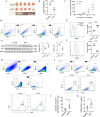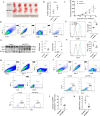ILC1-derived IFN-γ regulates macrophage activation in colon cancer
- PMID: 37679802
- PMCID: PMC10486120
- DOI: 10.1186/s13062-023-00401-w
ILC1-derived IFN-γ regulates macrophage activation in colon cancer
Erratum in
-
Correction: ILC1-derived IFN-γ regulates macrophage activation in colon cancer.Biol Direct. 2023 Dec 4;18(1):83. doi: 10.1186/s13062-023-00432-3. Biol Direct. 2023. PMID: 38049857 Free PMC article. No abstract available.
Abstract
Background: Tumor-associated macrophages (TAMs) are an important subset of innate immune cells in the tumor microenvironment, and they are pivotal regulators of tumor-promoting inflammation and tumor progression. Evidence has proven that TAM numbers are substantially increased in cancers, and most of these TAMs are polarized toward the alternatively activated M2 phenotype; Thus, these TAMs strongly promote the progression of cancer diseases. Type 1 innate lymphocytes (ILC1s) are present in high numbers in intestinal tissues and are characterized by the expression of the transcription factor T-bet and the secretion of interferon (IFN)-γ, which can promote macrophages to polarize toward the classically activated antitumor M1 phenotype. However, the relationship between these two cell subsets in colon cancer remains unclear.
Methods: Flow cytometry was used to determine the percentages of M1-like macrophages, M2-like macrophages and ILC1s in colon cancer tissues and paracancerous healthy colon tissues in the AOM/DSS-induced mouse model of colon cancer. Furthermore, ILC1s were isolated and bone marrow-derived macrophages were generated to analyze the crosstalk that occurred between these cells when cocultured in vitro. Moreover, ILC1s were adoptively transferred or inhibited in vivo to explore the effects of ILC1s on tumor-infiltrating macrophages and tumor growth.
Results: We found that the percentages of M1-like macrophages and ILC1s were decreased in colon cancer tissues, and these populations were positively correlated. ILC1s promoted the polarization of macrophages toward the classically activated M1-like phenotype in vitro, and this effect could be blocked by an anti-IFN-γ antibody. The in vivo results showed that the administration of the Group 1 innate lymphocyte-blocking anti-NK1.1 antibody decreased the number of M1-like macrophages in the tumor tissues of MC38 tumor-bearing mice and promoted tumor growth, and adoptive transfer of ILC1s inhibited tumors and increased the percentage of M1-like macrophages in MC38 tumor-bearing mice.
Conclusions: Our studies preliminarily prove for the first time that ILC1s promote the activation of M1-like macrophages by secreting IFN-γ and inhibit the progression of colon cancer, which may provide insight into immunotherapeutic approaches for colon cancer.
Keywords: Colon cancer; Group 1 innate lymphocytes; IFN-γ; M1 macrophage; Tumor-associated macrophage.
© 2023. BioMed Central Ltd., part of Springer Nature.
Conflict of interest statement
The authors declare that they have no competing interests.
Figures





Similar articles
-
Suppression of microRNA activity amplifies IFN-γ-induced macrophage activation and promotes anti-tumour immunity.Nat Cell Biol. 2016 Jul;18(7):790-802. doi: 10.1038/ncb3371. Epub 2016 Jun 13. Nat Cell Biol. 2016. PMID: 27295554
-
Tumor cell-released autophagosomes (TRAPs) promote immunosuppression through induction of M2-like macrophages with increased expression of PD-L1.J Immunother Cancer. 2018 Dec 18;6(1):151. doi: 10.1186/s40425-018-0452-5. J Immunother Cancer. 2018. PMID: 30563569 Free PMC article.
-
Tumor microenvironment remodeling and tumor therapy based on M2-like tumor associated macrophage-targeting nano-complexes.Theranostics. 2021 Jan 1;11(6):2892-2916. doi: 10.7150/thno.50928. eCollection 2021. Theranostics. 2021. PMID: 33456579 Free PMC article.
-
Macrophage Polarization: Different Gene Signatures in M1(LPS+) vs. Classically and M2(LPS-) vs. Alternatively Activated Macrophages.Front Immunol. 2019 May 24;10:1084. doi: 10.3389/fimmu.2019.01084. eCollection 2019. Front Immunol. 2019. PMID: 31178859 Free PMC article. Review.
-
The role of intestinal macrophage polarization in colitis-associated colon cancer.Front Immunol. 2025 Mar 5;16:1537631. doi: 10.3389/fimmu.2025.1537631. eCollection 2025. Front Immunol. 2025. PMID: 40109347 Free PMC article. Review.
Cited by
-
Dendritic Cell-Based Cancer Vaccines: The Impact of Modulating Innate Lymphoid Cells on Anti-Tumor Efficacy.Cells. 2025 May 30;14(11):812. doi: 10.3390/cells14110812. Cells. 2025. PMID: 40497988 Free PMC article. Review.
-
Investigation of pre and postoperative Th1/Th2 cytokine balance and novel cytokines in colorectal cancer patients.Clin Exp Med. 2024 Sep 4;24(1):211. doi: 10.1007/s10238-024-01480-3. Clin Exp Med. 2024. PMID: 39230623 Free PMC article.
-
The role of innate immune cells in the colorectal cancer tumor microenvironment and advances in anti-tumor therapy research.Front Immunol. 2024 Jul 19;15:1407449. doi: 10.3389/fimmu.2024.1407449. eCollection 2024. Front Immunol. 2024. PMID: 39100676 Free PMC article. Review.
-
Immune-response gene 1 deficiency aggravates inflammation-triggered cardiac dysfunction by inducing M1 macrophage polarization and aggravating Ly6Chigh monocyte recruitment.Biol Direct. 2024 Sep 30;19(1):86. doi: 10.1186/s13062-024-00521-x. Biol Direct. 2024. PMID: 39350193 Free PMC article.
-
Emerging roles of type 1 innate lymphoid cells in tumour pathogenesis and cancer immunotherapy.Explor Target Antitumor Ther. 2024;5(2):296-315. doi: 10.37349/etat.2024.00219. Epub 2024 Apr 23. Explor Target Antitumor Ther. 2024. PMID: 38745765 Free PMC article. Review.
References
Publication types
MeSH terms
Substances
LinkOut - more resources
Full Text Sources

